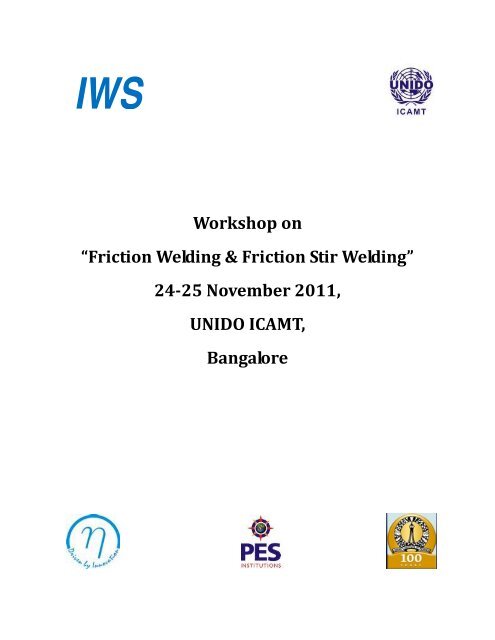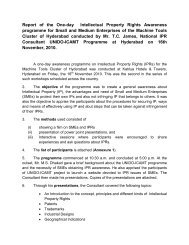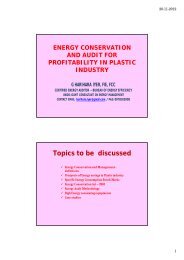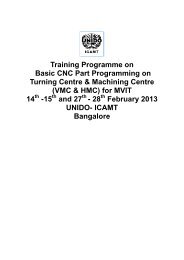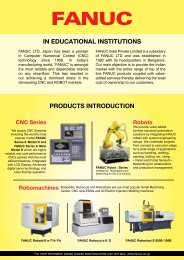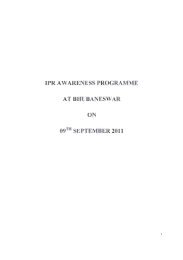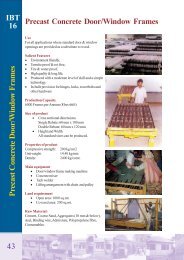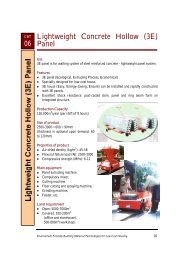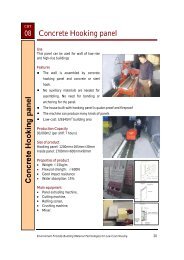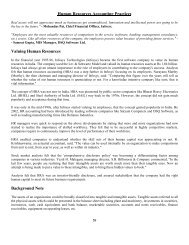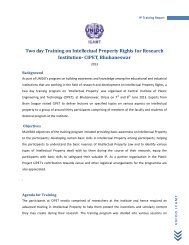Friction Welding & Friction Stir Welding - UNIDO-ICAMT
Friction Welding & Friction Stir Welding - UNIDO-ICAMT
Friction Welding & Friction Stir Welding - UNIDO-ICAMT
You also want an ePaper? Increase the reach of your titles
YUMPU automatically turns print PDFs into web optimized ePapers that Google loves.
IWSWorkshop on“<strong>Friction</strong> <strong>Welding</strong> & <strong>Friction</strong> <strong>Stir</strong> <strong>Welding</strong>”24-25 November 2011,<strong>UNIDO</strong> <strong>ICAMT</strong>,Bangalore
ContentS. No. Details Page No.1. Workshop Schedule 32. Programme Objective & Coverage 43. About Partner Organisations 64. Technical sessions 75. Feedback Form Analysis 96. Annexures 1 - List of Participants 127. Annexure 2 - Press Coverage in Leading Local Newspapers 148. Annexure 3 - Photos 159. Annexure 4- Course Material 1810. Annexure 5 – Feedback Forms2
Workshop on “<strong>Friction</strong> <strong>Welding</strong> & <strong>Friction</strong> <strong>Stir</strong> <strong>Welding</strong>”24 and 25 November, 2011Venue: <strong>UNIDO</strong> <strong>ICAMT</strong>, BangaloreWorkshop ScheduleDate Time Details24 th Nov. 201125 th Nov.20110900 – 1000 Hrs Registration1000 – 1030 Hrs Inauguration1030 – 1115 Hrs Technical Session 1(Mr Kasturi, ETA Technology, Bangalore)1130 – 1215 Hrs Technical Session 2(Dr Ashok kumar BHEL, Trichy)1215 – 1300 Hrs Technical Session 3(Dr V. Balasubramanian, Annamalai University)1300 – 1345 Hrs Technical Session 4(Dr Satish Kailas, IISC, Bangalore)1345 – 1430 Hrs Working Lunch1500 – 1730 Hrs Demonstration of FW Equipments at ETA Technology0930– 1015 Hrs Technical Session 5(Dr Madhusudan Reddy, DMRL, Hyderabad)1030 – 1115 Hrs Technical Session 6(Dr K.G.K. Murthy, GRIET, Hyderabad)1115 – 1200 Hrs Technical Session 7(Dr P. Srinivasa Rao, LPSC, ISRO, Bangalore)1200 – 1315 Hrs Question and Answer session1315 – 1415 Hrs Working Lunch1500 – 1630 Hrs Demonstration of FSW Equipments at IISC, Bangalore1645 – 1700 Hrs Certificate distribution at IISC, Bangalore3
Programme Objective & Coverage<strong>UNIDO</strong> <strong>ICAMT</strong> and Indian <strong>Welding</strong> Society, Bangalore Center in association with PES Instituteof Technology, Bangalore; ETA Technology, Bangalore; IISC, Bangalore jointly organized atwo day workshop on “<strong>Friction</strong> <strong>Welding</strong> and <strong>Friction</strong> <strong>Stir</strong> <strong>Welding</strong> Technology” during 24- 25November 2011 at <strong>UNIDO</strong> <strong>ICAMT</strong>, Bangalore.About the WorkshopThe inaugural function of the two day workshop was presided over by Mr. M.S. Dhakad,Programme Director, <strong>UNIDO</strong> <strong>ICAMT</strong> and Mr P.S. Nair, ETA Technology Pvt. Ltd., Bangalore.The Programme Director highlighted the importance of friction welding technology in a dynamicmachine tool industry. Mr. Nair shared the growth story of ETA Technology in the context offriction welding. Dr K. Narasimha Murthy, Chairman, Indian <strong>Welding</strong> Society, Bangalore Centerwelcomed the gathering and Dr V.P. Raghupathy, Professor, PES Institute of Technologydelivered the vote of thanks.The workshop intended to benefit design and manufacturing engineers from Automobile,Aerospace, and Process Engineering Sectors by improving their knowledge base and skill levelsand also obtaining first-hand information on the intricacies of the new manufacturingtechnology.The list of the participants and their affiliation is indicated in Annexure -1. In all 40 personsparticipated in the workshop. To all the delegates of the workshop “Participation Certificate’s”authorized by Mr M.S. Dhakad, Programme Director, <strong>UNIDO</strong> <strong>ICAMT</strong> and Dr K. NarasimhaMurthy, Chairman, Indian <strong>Welding</strong> Society, Bangalore Center were distributed.<strong>Friction</strong> welding (FW) and <strong>Friction</strong> <strong>Stir</strong> <strong>Welding</strong> (FSW) are important classes of solid-statewelding processes which find immense applications worldwide. Wherein the combination of fastjoining times (order of a few seconds), and direct heat input at the weld interface, yieldsrelatively “melt-free” and "clean" joints. These are new technologies and require in-depthknowledge of the process parameters and a multitude of metallurgical phenomena.The objective of this workshop was to bring to focus all the technological issues to the forefrontand help the practicing engineers to come to grips with the latest cutting edge technology. Itbrought experts from GRIET, Hyderabad, DMRL, Hyderabad, WRI, BHEL, Trichy, LPSC,ISRO, Annamalai University, ETA Technology, Bangalore and IISC, Bangalore to delivertechnical lectures on various aspects of <strong>Friction</strong> <strong>Welding</strong>, <strong>Friction</strong> <strong>Stir</strong> <strong>Welding</strong> and share theirrich experience.4
The following resource persons delivered technical lectures at the workshop:Dr K. Asok KumarDr K.G.K. MurthyMr T.S.KasthuriDr Madhusudan ReddyDr Satish KailasDr V. BalasubramaniamDr P. Srinivasa Rao: Additional General Manager, BHEL, Tiruchirappalli: Professor, GRIET, Hyderabad: Chief Executive Officer, ETA Technology, Bangalore: Joint Director, DMRL, Hyderabad: Professor, IISc, Bangalore: Professor, Annamalai University: Scientist, LPSC, ISRO, BangaloreUsing Inputs from reputed experts in the field, the Course material was prepared. This coursematerial includes the following:<strong>Friction</strong> <strong>Welding</strong> – An overview by T.S. Kasturi, ETA Technology<strong>Friction</strong> <strong>Welding</strong> – Process principles Dr. K.A. Asok Kumar, BHEL, Trichy<strong>Friction</strong> <strong>Welding</strong> – Process – Applications – Testing by Dr. K.G.K. MurtiMurthy,GRIET, Hyderabad<strong>Friction</strong> <strong>Stir</strong> <strong>Welding</strong>: A revolutionary process by Dr V. Balasubramanian,Annamalai University<strong>Friction</strong> surfacing of metallic coatings on steels, by Dr G. Madhusudhan Reddy, DMRL,Hyderabad<strong>Friction</strong> <strong>Stir</strong> <strong>Welding</strong> and <strong>Friction</strong> <strong>Stir</strong> Processing by Dr Satish Kailas, IISC, Bangalore<strong>Friction</strong> <strong>Stir</strong> welding of Austempered Ductile Iron using Interlayer Technology byS.V. Satish and Dr V.P. RaghupathyBS 622: <strong>Friction</strong> welding of Joints in MetalsJIS Z 3607: Recommended practice for friction welding of carbon steelAWS D 17.3: Specification for <strong>Friction</strong> <strong>Stir</strong> <strong>Welding</strong> of Aluminum Alloys forAerospace Applications.Press coverageDetails of the workshop and inaugural function was communicated to leading local newspapersand some of them published the event in the dailies and the extracts are indicated in Annexure –2.The photographs of <strong>Friction</strong> <strong>Welding</strong> workshop are in Annexure –3.The Course material is annexed in Annexure 4.5
About the Partner organizationsThe International Centre for Advancement of Manufacturing Technology (<strong>ICAMT</strong>) is anInternational Technology Centre of the United Nations Industrial Development Organization(<strong>UNIDO</strong>) promoting manufacturing technologies & innovations as the means to enhanceindustrial competitiveness in India & other developing countries. It provides a platform foreffective dissemination& transfer of knowledge on technological advances amongst variousindustrial sectors with a focus on small & medium enterprises. It acts as a catalyst in bridging thegap between the emerging market demands for new products, industry needs in emergingtechnologies & the existing technology base. Through its international network, globalrecognition & its engagement at the grass root level, <strong>UNIDO</strong>-<strong>ICAMT</strong> is a true technologypartner in progress.Indian <strong>Welding</strong> Society is a Professional body, Registered under Societies Registration Act. TheMission of this Society is to serve as knowledge sharing platform in <strong>Welding</strong> and allied fieldsand spread the latest developments in welding technology through different Centers and Zonesspread across the country.PES Institute of Technology, Bangalore is a premier autonomous engineering institution thatpromotes technological excellence.ETA Technology, Bangalore is a global leader in the manufacture of a wide range of high-tech<strong>Friction</strong> welding machines, Linear <strong>Friction</strong> welding machine, <strong>Friction</strong> stir welding machines &special purpose machines widely used in the automotive components manufacture, Aerospacecomponents & Drill pipe manufacture to mention a few. Driven by innovation ETA excels inproviding engineering solution for various industrial applications. It is also part of the BangaloreMachine Tool Cluster.Indian Institute of Science (IISC), Bangalore is a premier institution of higher education“University of Research” in India with a hundred years of dedication.****6
Technical sessionsIn the morning of the first day’s session, three technical papers were presented, one on <strong>Friction</strong><strong>Welding</strong> and two papers on <strong>Friction</strong> <strong>Stir</strong> welding Technology. Mr Kasturi T.S., Chief ExecutiveOfficer, ETA Technology, Bangalore explained how the process of rotary friction welding isimplemented in a modern day Machine. The principal mechanical elements as well as control &display Elements of a typical <strong>Friction</strong> <strong>Welding</strong> Machine was elaborated. He also narrated theoperation sequence of the machine and how to set different process parameters in the machine.He brought out various practical considerations to make a quality weld joint. He also deliberatedon different types of commercially available <strong>Friction</strong> welding equipments as mentioned below:- 125 T single head <strong>Friction</strong> welding machine- 150 T double head <strong>Friction</strong> welding machine- 3 T vertical <strong>Friction</strong> welding machine- 15 T <strong>Friction</strong> welding machine with built-in deflash- 6 T slant head <strong>Friction</strong> welding machineDr V. Balasubramanian, Professor & Director, Centre for Materials Joining & Research(CEMAJOR), Department of Manufacturing Engineering, Annamalai University delivered a talkon “<strong>Friction</strong> <strong>Stir</strong> <strong>Welding</strong>: A Revolutionary Process”. He narrated how <strong>Friction</strong> <strong>Welding</strong>Technology got evolved in U.K. and gave a historical perspective of the process basically meantfor plates and structural configurations. He spoke at length on the use and adaptation of thistechnology to Cast and wrought Aluminum alloy products, Copper alloys, Magnesium alloys,Carbon steels and Stainless steels. He also brought out safe welding windows for each categoryof the metal so as to obtain defect free welds.Dr Satish V. Kailas, Professor, Department of Mechanical Engineering, Indian Institute ofScience, Bangalore delivered a talk on “<strong>Friction</strong> <strong>Stir</strong> <strong>Welding</strong> and <strong>Friction</strong> <strong>Stir</strong> Processing”. Heexplained the principle of <strong>Friction</strong> <strong>Stir</strong> <strong>Welding</strong> and <strong>Friction</strong> <strong>Stir</strong> Processing wherein process, anon-consumable rotating tool, which has a shoulder, is plunged into the weld interface andmoved forward. The shoulder generates significant amount of heat in the material being welded,increasing it temperature and lowering its flow stress. The rotating action stirs the material andthe forward motion makes the material from the front of the weld move to the rear portion of theweld. The large amount of strain induced and the stirring action of the tool eliminates theoriginal weld interface and welds the two plates together. He also emphasized that among themany parameters that control the weld quality and strength are the tool geometry, tool rpm,traverse speed, normal load applied by the tool and weld interface position. While the largenumber of parameters allow for precise control of the weld strength, it also poses a challenge onwhat are the optimal weld parameters, especially because they are interlinked in a, many-attimes,non-linear relationship. Further, he focused on how to go about reaching this “optimalpoint”, for a given tool geometry, with minimal number of trials. The effect of the normal loadapplied by the tool and tool interface position is specially emphasized on in this talk. He alsohighlighted how the process introduces a large strain on the deforming material and thus isamenable to being used to produce ultra-fine grained and near-nano grained material. Some ofthe work being done in this direction were presented and there was lively discussion.7
In the afternoon Session of the first day, the participants were given hands on training on latest<strong>Friction</strong> <strong>Welding</strong> machines at ETA Technology. The working of different types of rotary andlinear <strong>Friction</strong> welding machines was demonstrated. The importance of setting correctparameters to achieve sound joints was practically explained on prototype components.In the morning of the second day’s session, four technical papers were presented, two papers on<strong>Friction</strong> <strong>Welding</strong> and two papers on <strong>Friction</strong> <strong>Stir</strong> welding Technology.Dr. K.A. Asokkumar, Additional General Manager, BHEL, Tiruchirappalli presented a talk on“<strong>Friction</strong> <strong>Welding</strong> – Process principles”. He described the practice of the friction welding intwo distinct modes; a. conventional or continuous drive friction welding and b. stored energy orinertia welding. He explained how the joint formation takes place in both the types of <strong>Friction</strong>welding and brought out the influence of rotary speed, pressure and heating time or burn off onthe joint efficiency. He also elaborated on the selection of typical parameters for continuousdrive <strong>Friction</strong> <strong>Welding</strong> and for Inertia <strong>Friction</strong> <strong>Welding</strong> for different types of similar anddissimilar materials joining. Dr. K.G.K. Murti, Professor, Head and Dean GRIET , Hyderabadgave a historical perspective on the evolution of <strong>Friction</strong> <strong>Welding</strong> Technology. He narrated theapplications of this technology in various engineering sectors. For example, <strong>Friction</strong> weldinghas been used in nuclear industry for joints between zirconium – aluminium – stainless steel,nickel – iron alloy / stainless steel and stainless steel / aluminium. In the aircraft industry also,friction welding finds application, e.g., for the joining of a turbine disc in a nickel – base alloy toturbine disc in a nickel – base alloy to a shaft in a gas turbine engine. The application of frictionwelding for the manufacture of nozzles of rocket motors and for joints between nodular cast ironpipe and steel pipe for construction use has been reported from Japan. Similarly the use offriction welding in the production of eccentric shafts for machine tools and agriculturalmachinery, the manufacture of bi-metal twist drills and the production of various types ofautomobile components has been reported from Europe.Dr G. Madhusudhan Reddy, Director, Defence Metallurgical Research Lab, Hyderabad delivereda talk on “<strong>Friction</strong> surfacing of metallic coatings on steels”. The topic was focused on how<strong>Friction</strong> surfacing machine has been employed to friction surface mild steel, Low Carbon LowAlloy Steel (LCLAS) and Medium Carbon Low Alloy Steel (MCLAS) with aluminum alloy6061, pure nickel, stainless steel, and aluminum metal matrix composites (MMC) AA 2124SiCp. Mild steel was coated with aluminum alloy, nickel, stainless steel, and MMC whileLCLAS was coated with stainless steel. MCLAS was friction surfaced with stainless steel as wellas nickel coating followed by stainless steel coating. Dr P. Srinivasa Rao, Scientist, LPSC, ISRO,Bangalore gave a lucid presentation on how <strong>Friction</strong> <strong>Stir</strong> <strong>Welding</strong> technology was adapted toSpace sector components. The stringent quality requirements were elaborated and how jigs andfixtures were designed and adopted to meet the dimensional accuracies.In the afternoon session, practical demonstrations on <strong>Friction</strong> <strong>Stir</strong> <strong>Welding</strong> with different typesof materials and edge configurations were given to the participants at IISC, Bangalore. Theparticipants had a lively interaction and got first hand information on various parameter settings.8
Feedback AnalysisThe feedback forms of the participants are indicated in Annexure 5. The feedback is essentiallyon the following aspects:• Significance of the Training program• Quality of Training• Usefulness of program• Course material• Comments and suggestions on the deliberations during technical sessions• Topics suggested by the delegates for future workshopsA summary of the participants feedback is given (table 1) below. On all the aspects mentionedabove, the respondents have given a score of 4 out of 5 which indicates “very good”. From thetopics indicated for future workshops by the delegates, following topics can be considered forfuture workshop and training:• Environmental issues in Electro-plating• NDT techniques as applicable to FW and FSW joints• Mathematical modeling of FW and FSW processes• Fracture toughness and Fatigue analysis of welded joints• On-line monitoring of FSW and FW• Linear <strong>Friction</strong> weldingSUMMARY OF FEEDBACK RECEIVED FROM DELEGATES (Table 1)RespondentNo.TrainingprogramQualityofTrainingUsefulnessofprogramCoursematerial1. 4 4 4 52. 5 5 5 53. 4 3 4 34. 4 5 5 45. 3 3 4 36. 5 4 5 57. 5 4 4 48. 5 4 5 5CommentsUseful tips on <strong>Friction</strong> stirwelding techniques obtained;Hand out is excellentThe inputs were quite useful toavoid defectsQuality & maintenance aspectscould have been focusedMore coverage of basics of<strong>Friction</strong> weldingProgram was helpful inoptimizing process parametersExplanation of graphical outputs were very helpfulIn-depth inputs have been givenin all aspects of FW and FSWUseful aspects of FW and FSWwere given; time constraintTopics for future workshop<strong>Friction</strong> <strong>Stir</strong> welding ofsteelDefects in TIG and PTAweldingInnovations in <strong>Welding</strong>Projection weldingElectro-plating<strong>Friction</strong> <strong>Stir</strong> surfacingLatest trends in FW andFSWDesign & metallurgicalaspects of FW & FSWMetallurgical aspects ofFW & FSW9
RespondentNo.TrainingprogramQualityofTrainingUsefulnessofprogramCoursematerial9. 5 4 5 410. 4 4 5 411. 4 3 4 412. 5 5 5 513. 4 4 4 414. 4 4 5 515. 4 3 2 316. 4 4 4 417. 3 3 3 418. 4 5 4 3CommentsVery useful information ondefects in FWVery useful information onapplication of FW & FSWVery useful information onfailures in FW & to avoid themUseful tips for research in FWand FSWUnderstood Importance ofthermal equilibrium in FWVery useful information onapplication of FW & FSWMore explanation on torquecurve and analysisMore knowledge about materialselection; will explorepossibility of using FSWVery useful information onapplication of FW & FSWAs 7 machines are being used,inputs were very useful19. 4 3 3 3 Useful tips for research in FSW -20. 5 3 4 4Useful tips for research in FSWTopics for future workshopMetallurgical aspects ofFW & FSWRobotics & Machinedesign; HydraulicsNDT techniques forEngine valves-Condition monitoring ofmachines ; low costautomationAdvances in FWOptimization of cuttingparameters; Optimizationof induction hardening-CNC MachiningFracture toughness andFatigue life of Al alloys21. 4 3 3 4 Useful tips for research in FSW Surface Engineering22. 4 4 4 423. 3 3 3 324. 5 5 4 425. 5 5 4 526. 5 5 5 427. 4 4 4 428. 3 5 3 429. 4 5 4 3Very useful information onapplication of FW & FSWVery useful information onapplication of FW & FSWUseful tips for research in FSWUseful information for researchin FW and FSWUseful information for researchin FW and FSWUseful information for researchin FW and FSWUseful information for researchin FW and FSW ; practicaldemonstration very usefulVery useful information onapplication of FW & FSW-Latest trends in FW andFSWFatigue strength ofdissimilar jointsModeling of FSW processparametersModeling of FSW processparametersRapid proto typingOn-line monitoring ofFSW and FWLinear <strong>Friction</strong> <strong>Welding</strong>Induction pressurewelding; Plasma <strong>Welding</strong>10
RespondentNo.TrainingprogramQualityofTrainingUsefulnessofprogramCoursematerial30. 3 3 3 331. 3 4 3 332. 3 3 4 433. 5 4 4 334. 4 4 4 4CommentsTraining was useful and we willexplore the possibility ofimplementing these processesVery useful information onapplication of FW & FSWVery useful information onbasic principles of FW & FSWUseful information for researchin FW and FSWVery useful information onbasic principles of FWTopics for future workshopMetallurgical aspects ofFW & FSWMetallurgical aspects ofFW & FSWTIG and Plasma <strong>Welding</strong>Metallurgical aspects of<strong>Welding</strong>Nano - materials-Aspects of trainingANALYSIS OF FEEDBACKMaximummarksMarks obtainedAverage scoreobtained out of 5Training program 170 140 4Quality of Training 170 136 4Usefulness of program 170 134 4Course material 170 133 411
ANNEXURE - 1Workshop on “<strong>Friction</strong> <strong>Welding</strong> & <strong>Friction</strong> <strong>Stir</strong> <strong>Welding</strong>”,24 and 25 November, 2011List of ParticipantsSl.No.NameAffiliation1. S. Sree Sabari Annamalai University2. R. Kamal Jayaraj Annamalai University3. M. Bakkiyaraj Annamalai University4. P. Sivaraj Annamalai University5. A. Baskaran Annamalai University6. Ashok Bhat Automotive Axles Ltd., Mysore7. Prasanna H G Automotive Axles Ltd., Mysore8. Virupakshappa Automotive Axles Ltd., Mysore9. L. Sankar Axles India Ltd., Chennai10. Nethaji .A Axles India Ltd., Chennai11. Chandra Shekar .A. B.I.T, Bangalore12. Shekhar Brahmankar Electro Crimp Contacts (I) Pvt. Ltd., Nasik13. Dr Deba Kumar Sarma IIT, Guwahati14. Yuvaraja Naik K.S.School of Engg. & Mangaement, Bangalore15. Dr Shailesh Rao K.S.School of Engg. & Mangaement, Bangalore16. C. Rudramurthy Kar Mobiles Ltd., Bangalore17. Ajay M Sonone Kar Mobiles Ltd., Bangalore12
18. Anil R.B. Kar Mobiles Ltd., Bangalore19. P. Manjunath Kar Mobiles Ltd., Bangalore20. Barnik Saha Roy NIT, Agartala21. Dr Mervin A. Herbert NITK, Surathkal22. C. Venkatesan Rane Engine Valve Ltd, Chennai23. L. Krishnappan Rane Engine Valve Ltd, Chennai24. C. Sairam Rane Engine Valve Ltd., Medchal.25. Gopi Krishnan.P Sri Krishna College of Technology, Coimbatore26. Sachin Kumar Toyoto Kirloskar Auto Parts, Bangalore27. Dr Rajaprakash B.M. U.V.C.E, Bangalore28. Vijay Sabbanwar Varroc Engineering Pvt Ltd., Aurangabad29. Yogesh Pawar Varroc Engineering Pvt Ltd., Aurangabad30.Kavitha AramvalarselviM.VKS College of Engg. & Technology, Karur31. Siddharth Shah Vulcan Industrial Engg. Co. Ltd., Gujarat32. Mangalasankara Eswaran Wipro Infrastructure Engineering., Bangalore33. Uvaraj. G. Wipro Infrastructure Engineering., Bangalore34. Raviprakash B G Wipro Infrastructure Engineering, Bangalore35. Channappa B Wipro Infrastructure Engineering, Bangalore36. Satish Bubu K. Wipro Infrastructure Engineering, Bangalore37. T. George Joseph Wipro Infrastructure Engineering, Bangalore38. Harsha R Gudi PES Institute of Technology39. Nirupama Mohan PES Institute of Technology40. Vijetha A. C. PES Institute of Technology13
ANNEXURE - 2Press Coverage in Leading Local NewspapersWorkshop on “<strong>Friction</strong> <strong>Welding</strong> & <strong>Friction</strong> <strong>Stir</strong> <strong>Welding</strong>”24 and 25 November, 2011KANNADA PRABHA: 24-11-2011SAMYUKTHA KARNATAKAVIJAYA KARNATAKA ; 24-11-201114
Workshop PhotographsANNEXURE - 3Dr K. Narasimaha Murthy & Mr M.S. DhakadMr M.S. Dhakad, Mr P.S. Nair & Dr V.P.RaghupathyMr P.S. Nair, Mr M.S. Dhakad, Dr K. NarasimahaMurthy & Dr V.P.RaghupathyDr V.P. Raghupathy, Mr P.S. Nair, Mr M.S. Dhakad,Dr K. Narasimaha Murthy15
Registration deskDelegates at the workshopDr Satish Kailas, IISC, Guest SpeakerDr K. Asok Kumar, BHEL, Guest SpeakerDr V. Balasubramanian, Annamalai University, GuestSpeakerDr K.G.K. Murthy, GRIET, Guest Speaker16
Dr Madhusudan Reddy, DMRL, Guest SpeakerDr P. Srinivasa Rao, ISRO, Guest SpeakerHands on Demonstration of <strong>Friction</strong> <strong>Welding</strong> ProcessVisit to ETA Technology, Bangalore17


